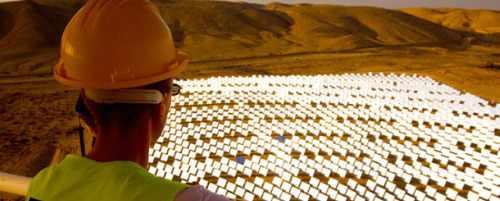With over $1 b. in US government loans, Israel’s BrightSource will build the world’s largest solar energy project in California, doubling the solar thermal electricity produced in the US today.

They clinked glasses and toasted for two seconds, and then it was back to work and business as usual, says Israel Kroizer from BrightSource Energy, a VC-funded solar thermal energy company, which has just received $1.37 billion in loan guarantees from the US government.
It was a well-planned process that took three years to roll out, Kroizer, the chief operating officer for BrightSource tells ISRAEL21c, and one that will put BrightSource, the US and Israeli solar energy entrepreneurs, on the solar energy map. It will be the first new solar thermal plant built in the state of California in about 20 years, and when completed by 2013 it will be the world’s largest solar energy project, nearly doubling the amount of solar thermal electricity produced in the US today.
With the new facility to be built in the Ivanpah region in southeastern California, plant engineers will begin construction this year and by 2013 the company plans to be powering about 140,000 Californian homes. More than a thousand jobs will be created in the interim, as well as millions of dollars in tax revenues.
BrightSource’s Ivanpah project comprises three separate solar thermal plants, producing about 400 megawatts of power. The US Department of Energy provided the loan guarantees that are so essential in these uncertain economic times. They are granted through the Department of Energy’s Title XVII loan-guarantee program that started in 2005 under the Energy Policy Act, to support commercially proven technologies.
With the loan guarantees secured and two major utility companies – Pacific Gas and Electric (PG&E) and Southern California Edison – ready to buy the energy created by BrightSource in the Ivanpah region, all the company needs now is financing for about half the amount of the loan guarantees, to bring its sunny dream of clean energy to California.
Land or solar energy?
It hasn’t been easy for the 200 or so employees, 150 in Israel and about 50 in the US. Recently, BrightSource had to scrap plans for an even bigger plant in the Mohave Desert, due to criticism from green groups concerned about the massive planned facility’s impact on the desert ecostructure and on wildlife such as the coyote.
“It’s an ongoing discussion between solar and green people on both sides of the ocean arguing about land. Sometimes you agree, sometimes you don’t,” says Kroizer, happy to be finally implementing the solar thermal plant in sun-drenched California.
The seed for BrightSource was planted in 1980 by Israeli entrepreneurs who started a company called Luz.
“About three-and-a-half to four years ago, we founded BrightSource, based on the foundations and the work of the people from Luz, which came together and brought in some young blood recently,” says Kroizer who was the first engineer to join Luz, some 30 years ago.
What the loan guarantees mean, says Kroizer is that the “Treasurer of the US will give us the loan. The project and companies will remain separate entities and the project will get a loan. PG&E, for example will be buying the energy, while BrightSource will build the power plant.” More financing is expected to come through private companies, he says.
Loan guarantees validate the technology
“The loan guarantee commitment from the US Department of Energy serves as a tremendous validation of our technology, the BrightSource team’s ability to execute, and the Ivanpah project’s role in meeting our nation’s large-scale renewable energy needs,” says John Woolard, CEO of BrightSource Energy, which maintains its headquarters in the US and runs an Israeli subsidiary based in Jerusalem, where its R&D is centered.
BrightSource’s technology is based on solar thermal energy generation, one of two major technology alternatives in today’s solar energy market. Solar thermal power generation uses the sun’s heat to increase the temperature of a working fluid, which is then used to generate power.
The other alternative, photovoltaic technology (PV for short), uses direct light from the sun to generate electricity. PV units include crystalline, multi-crystalline, thin-film or concentrators, while solar thermal technologies employ variations of troughs, power towers, thermal electric technologies or dish engines.
BrightSource’s solution connects thousands of mirrors, all focused on a water boiler sitting atop a tower. When the sun heats the boiler, water inside it becomes steam, which is then piped into a conventional turbine to create power.
A thumbs-up from Schwarzenegger
At the Ivanpah facility, BrightSource Energy will fire up its Luz Power Tower technology to generate electricity in much the same way it is done in traditional power plants, except that here high temperatures created by the sun, not fossil fuel, will create the steam that turns a turbine.
“As home to some of the world’s best solar fields and the nation’s largest green economy, it is no surprise the world’s largest solar energy project would choose California,” says California’s Governor Arnold Schwarzenegger.
“Our ambitious environmental policies are promoting the growth of clean, reliable energy in our communities and growing green jobs up and down the state. And it is projects like this one that will help us meet our long-term energy and climate change goals, while creating jobs and moving us towards a cleaner more sustainable future,” he concludes in a press statement.












